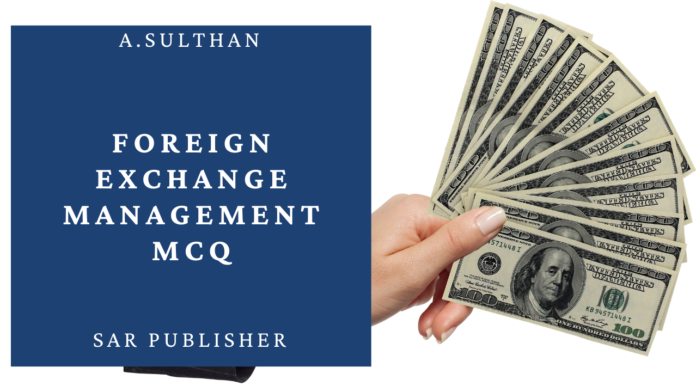Foreign Exchange Management MCQ Questions and Answers Part – 1
Foreign Exchange Management MCQ Questions and Answers Part – 2
Foreign Exchange Management MCQ Questions and Answers Part – 3
51. The net potential gain or loss likely to arise from exchange rate changes is-
A. exchange exposure
B. exchange risk
C. profit/loss on foreign exchange
D. exchange difference
ANSWER: B
52. The exchange loss/gain due to transaction exposure is reckoned on-
A. entering into a transaction in foreign exchange
B. quoting a price for a foreign currency transaction
C. conversion of foreign currency into domestic currency
D. entry in the books of accounts
ANSWER: C
53. Transaction exposure can be hedged
A. by internal methods only
B. by external methods only
C. either by internal methods or by external methods, but not by both
D. either by internal methods or by external methods or a combination of both
ANSWER: D
54. The external methods of hedging transaction exposure does not include-
A. forward contract hedge
B. money market hedge
C. cross hedging
D. futures hedging
ANSWER: C
55. The true cost of hedging transaction exposure by using forward market is-
A. the difference between the agreed rate and the spot rate at the time of entering into the contract
B. the difference between the agreed rate and the spot rate on the due date of the contract.
C. the forward premium/discount annualised
D. none of the above
ANSWER: B
56. Money market hedge involves-
A. borrowing/investing the concerned currency in the money market and squaring the position on the
due date of receivable/payable
B. borrowing/investing the concerned currency in the money market and covering the position immediately in the forward market.
C. covering an exposure int he domestic currency
D. simultaneous borrowing and lending int he money market.
ANSWER: A
57. The cost of hedging through options includes-
A. option premium
B. interest on option premium till due date of the contract
C. both (a) and (b) above
D. (a) above and differences between option price and spot price.
ANSWER: C
58. Hedging with options is best-recommended for-
A. hedging receivables
B. hedging contingency exposures
C. hedging foreign currency loans.
D. hedging payables
ANSWER: B
59. A firm operating in India cannot hedge its foreign currency exposure through
A. forwards
B. futures
C. options
D. none of the above
ANSWER: B
60. Internal hedge for transaction exposure does not include-
A. exposure netting
B. choosing currency of invoicing
C. cross hedging
D. none of the above
ANSWER: D
61. Foreign currency exposure can be avoided by
A. entering into forward contracts
B. denominating the transaction in domestic currency
C. exposure netting
D. maintaining foreign currency account
ANSWER: B
62. Maintaining a foreign currency account is helpful to-
A. avoid transaction cost
B. avoid exchange risk
C. avoid both transaction cost and exchange risk
D. avoid exchange risk and domestic currency depreciation
ANSWER: C
63. The following method does not result in sharing of exchange risk between importer and exporter-
A. denominating in a third currency
B. denominating partly in the importer’s currency and partly in the exporter’s currency.
C. entering an exchange rate clause in the contract
D. denominating in domestic currency
ANSWER: D
64. Leading refers to-
A. advancing of receivables
B. advancing of payables
C. advancing payments either receivables or payables
ANSWER: C
65. Translation exposure arises in respect of items translated at –
A. current rate
B. historical rate
C. average rate
D. all the above
ANSWER: A
66. Translation loss is-
A. a loss to the parent company
B. a loss to the subsidiary company
C. a notional loss
D. an actual loss
ANSWER: C
67. The translation exposure is positive when-
A. exposed assets are lesser than exposed liabilities
B. exposed liabilities are lesser than exposed assets
C. the exposure results in profit
D. there are no agreed liabilities
ANSWER: B
68. For the purpose of translation, current rate refers to-
A. the rate current at the time of the transaction
B. the rate prevalent on the date of the balance sheet
C. the rate prevalent on the date of preparation of the balance sheet
D. the spot rate
ANSWER: B
69. For the purpose of translation exposure, the historical rate is the rate prevalent on the date-
A. the parent company was established
B. the foreign subsidiary was established
C. the investment in the subsidiary was made by the parent company
D. the asset was acquired or the liability was incurred
ANSWER: D
70. Exposed assets are those translated at-
A. historical rate
B. average rate
C. current rate
D. current rate or average rate.
ANSWER: C
71. A positive exposure will lead to ………….when the currency of the subsidiary company appreciates.
A. translation gain
B. translation loss
C. exchange gain
D. exchange loss
ANSWER: A
72. Translation loss may occur when-
A. exposed assets exceed exposed liabilities and foreign currency appreciates
B. exposed assets exceed exposed liabilities and foreign currency depreciates
C. the subsidiary’s balance sheet shows a loss
D. the foreign currency depreciates
ANSWER: B
73. The following method cannot be used for managing translation exposure
A. forward contract
B. option contract
C. exposure netting
D. leading and lagging
ANSWER: B
74. The method of managing translation exposure that is also available for managing transaction exposure is-
A. balance sheet hedge
B. transfer pricing
C. swaps
D. none of the above
ANSWER: D
75. Economic exposure does not deal with-
A. changes in real exchange rates
B. future cash flows of the firm
C. expected exchange rate changes
D. none of the above
ANSWER: C
76. If the rupee depreciates in real terms, cash inflows of a firm engaged in exports is-
A. definite to increase
B. definite to decrease
C. generally will increase, if the government does not intervene.
D. will increase provided the demand for its exports is elastic.
ANSWER: D
77. Market selection as a strategy to manage economic exposure requires-
A. preferring domestic market to foreign market
B. preferring market with fixed exchange rate
C. shifting to a market whose currency has appreciated
D. shifting to a market whose currency has depreciated
ANSWER: C
78. Ideal time for launching a product in a foreign market is
A. when domestic currency has depreciated
B. when domestic currency has appreciated
C. when exchange rate in the markets are fluctuating violently
D. none of the above
ANSWER: A
79. Production strategies for managing economic exposure do not include-
A. importing input if local currency appreciates
B. shifting production to a country whose currency has not appreciated
C. shifting production to a low-cost centre
D. reviving uneconomic units
ANSWER: D
80. Financial strategies for managing economic exposure does not include-
A. minimising cost of borrowing by sourcing from cheaper market
B. matching of assets and liabilities in a currency
C. securing parallel loans and swaps
D. delaying the product launch
ANSWER: D
81. The transaction in which the bank receives foreign currency from the customer and pays him in local
currency is a –
A. purchase transaction
B. sale transaction
C. direct transaction
D. indirect transaction
ANSWER: A
82. The transaction in which the bank receives local currency from the customer and pays him foreign
currency is a-
A. purchase transaction
B. sale transaction
C. direct transaction
D. indirect transaction
ANSWER: B
83. The following is not a sale transaction of foreign exchange:
A. issue of a foreign demand draft
B. payment of an import bill
C. realisation of an export bill
D. none of the above
ANSWER: C
84. Interest for the transit period is included in –
A. bill buying rate
B. bill selling rate
C. usance bill buying rate
D. none of the above
ANSWER: D
85. The exchange margin included by a bank in the exchange rate quoted to the customer is-
A. prescribed by Reserve Bank
B. prescribed by FEDAI
C. determined by the bank concerned within the limits prescribed by FEDAI
D. determined by the bank concerned
ANSWER: D
86. The minimum fraction in which exchange rates are quoted by banks to their customers is-
A. 0.0001
B. 0.005
C. 0.0025
D. 0.01
ANSWER: C
87. The exchange rates quoted by an authorised dealer to its customers are known as-
A. authorised rates
B. commercial rates
C. merchant rates
D. indirect rates
ANSWER: C
88. TT buying rate is not applicable for the following transaction-
A. encashment of a DD for which cover has already been received
B. encashment of an MT for which paying bank has to make reimbursement claim with the issuing
bank.
C. realisation of a foreign bill sent for collection
D. payment of a cable transfer.
ANSWER: B
89. Bill buying rates are applicable to
A. all export transactions
B. any transaction to which TT buying rate is not applicable
C. realisation of a foreign bill sent for collection
D. only for purchase/negotiation of export bills
ANSWER: D
90. As per FEDAI Rules, the rupee value of all foreign exchange transactions should be rounded off tto-
A. nearest rupee
B. nearest ten rupees
C. nearest paise
D. nearest ten paise
ANSWER: A
91. Buying rate for ready merchant rate is derived from-
A. interbank spot buying rate
B. interbank ready buying rate
C. interbank spot selling rate
D. interbank ready selling rate
ANSWER: A
92. The quotation for merchant transaction is-
A. two-way quotation
B. applicable to all merchant transactions uniformly
C. specific to the transaction for which it is quoted
D. applicable only for traders.
ANSWER: C
93. An export bill is taken for collection by the bank. The exchange rate applied for the transaction will be:
A. bill buying rate
B. bill selling rate
C. TT buying rate as on the date of sending the bill for collection
D. TT buying rate as on the date of realisation of the bill
ANSWER: D
94. An import customer accepts a bill drawn on him. The bank will apply-
A. bill selling rate
B. bill acceptance rate
C. TT selling rate
D. no exchange rate, since no foreign exchange transaction is executed
ANSWER: D
95. TT buying rate is applicable for transactions where-
A. remittance is received by telecommunicaton
B. remittance is sent by telecommunication
C. the nostro account of the bank is already credited
D. the nostro account of the bank is already debited
ANSWER: C
96. The term notional due date refers to-
A. the date on which an export bill is likely to be paid
B. due date arrived at without considering the holidays
C. due date of a bill drawn without a due date
D. none of the above
ANSWER: A
97. TT selling rate is applicable for transactions of1/
A. issue of telegraphic transfers
B. outward remittances other than for retirement of import bill
C. retirement of import bill for which remittance is sent by TT
D. payment of telegraphic transfer
ANSWER: B
98. In calculating cross rates, exchange margin is entered-
A. only once in the dollar/rupee rate
B. only once in the dollar/foreign currency rate
C. twice in the dollar/rupee rate and dollar/foreign currency rate
D. twice in the dollar/rupee rate and dollar/foreign
ANSWER: A
99. The merchant rate for pound sterling is calculated by banks in India-
A. directly based on interbank sterling/rupee rate
B. directly based on RBI rate for sterling
C. as a cross rate using dollar/rupee rate and dollar/sterling rate
D. as a cross rate using Euro/rupee rate and Euro/sterling rate
ANSWER: C
100. For calculating cross currency rates, banks in India use the dollar/foreign currency rate quoted in
A. Mumbai
B. London
C. New York
D. any international market
ANSWER: D


